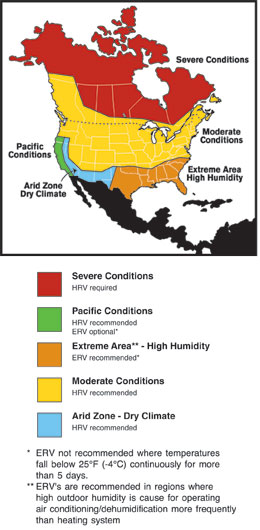Through a combination of fans, controls, and heat recovery elements, both ERVs and heat recovery ventilators (HRVs) bring in fresh air from the outdoors and exhaust stale air from the home, creating a balanced ventilation system. Continuously running, they provide a steady supply of fresh air while recovering a portion of the energy normally lost through nonheat recovery ventilation.
But in an industry cluttered by often-unsubstantiated claims, anecdotal evidence, and inaccuracies, a debate ensues over the effectiveness of ERVs in northern climates - focusing on such concerns as the durability and long-term reliability of the systems.
"The durability of ERVs is certainly a concern," said Dennis Dietz, Ph.D., vice president of engineering with Sarasota, Fla.-based American ALDES Ventilation Corp. "Homeowners should be asking how long the unit is going to last in a cold climate, how immune is the product to freeze damage?"

CORE DAMAGE AND HUMIDITY
"Many manufacturers claim ERV cores are made of resin static plates, but these are actually paper-based cores, which often freeze. When ERV cores are exposed to low temperatures, the paper resin material will absorb the water, which will freeze. If you have liquid condensation on the core, that liquid gets into the paper, comprising the core."In the Green Bay area, one company rep told me he had replaced units that had been used in the prior winter," said Dietz. "They froze, destroyed themselves, turned into mush. The paper had disintegrated. I really have concerns about the excessive use of ERVs in cold climates."
Ola Wettergren, president of Fantech and chairman of the Home Ventilating Institute (HVI), said that while his company sells both HRVs and ERVs, he steers customers in northern climates away from the latter.
"Typically we say that ERVs are ideal in southern climates where hot, humid weather is predominant and air conditioning is used most of the year," he said. "In northern climates, ERVs can actually add to humidity problems if the indoor humidity is already high, as is typical in new construction homes. Unlike an HRV, the ERV will allow humidity back into the building, adding to the problem," said Wettergren.
"Generally the performance difference between the two is not great enough to justify using an ERV in colder climates. It's better to have a humidifier for adding humidity and an HRV to control elevated humidity and efficiently introduce fresh air."
"An HRV has a lifetime warranty on the core [heat exchanger element]," Wettergren explained. "An ERV in a northern climate likely has a more limited lifespan, so logically the HRV is the better choice and the one we suggest. An HRV core can be easily cleaned and there is no question about durability or buildup in the core. You could go back six, seven, eight years or more after the purchase and the HRV is very likely to be functioning exactly the same way at the time of purchase."

HOMEOWNER EDUCATION
Homeowners are confronted with a number of issues when considering the installation of an ERV or HRV in their homes.Nutech, for example, looked carefully at marketing ERVs to both warm and cold climates, but it had a requirement that the ERVs must survive a cold winter. In testing, however, ERVs just did not work satisfactorily, so the company continues to advocate HRVs for cold climates.
You can put a lifetime warranty on cores that are aluminum based, which is what Nutech uses as its heat transfer material. Paper has a much shorter warranty period. The problem is that consumers really don't know if their heat exchanger has been damaged by water or ice. When the ERV core is damaged, it may not be evident. Deterioration of the ERV core leads to leakage and a loss of efficiency and airflow - another major problem.
I tell potential customers the most reliable way of avoiding these problems is to check the Home Ventilating Institute (HVI) Website (www.hvi.org). Founded in 1955, HVI is the premier nonprofit association of home ventilating product manufacturers. It represents a wide range of home ventilating products made by companies in the United States, Canada, Asia, and Europe.
A salesperson can say whatever he wants. But to get the real information, you just look up the product on the Website to find out under what conditions the system was tested. You'll find that almost all ERVs are tested at temperatures above 32°F. This will tell the consumer that there is an issue.
If an ERV was truly suitable for regions of North America where temperatures fall below freezing in the winter, it should have a defrost mechanism installed, and ratings related to temperatures experienced in those regions. A very common rating for cold temperatures in North America is -13°. Some of the ERV cores in our labs, and even HRVs without proper defrost mechanisms, will start to freeze well above -13°.
QUALIFIED CLAIMS
Dietz said even companies that extol the virtues of using ERVs in colder climates do so with qualifiers attached to their claims. “There is a hesitation in their own literature about the use under certain conditions. It’s clear that you need to have the indoor conditions dry, otherwise they will not have frost-free performance. The systems will freeze and potentially damage themselves.”Wettergren, who has an extensive background as an aeronautical engineer, said that while there are different views on the subject, there is no dispute over the climate map from Building Science Corp.
“It really makes what product to use quite clear.”
“We manufacture both ERVs and HRVs,” he said. “My direct advice is that an HRV is a better choice anywhere you have conditions that will cause freezing inside the machinery. [HRVs] are clearly the better choice under such conditions.”
Grinbergs is chairman of the HRV and ERV Committee of HVI (www.hvi.org).
Editor’s Note: Letters from the Board of Directors of HVI and from Douglas Steege of RenewAire were later published that refute opinions expressed in this article. To read those letters, click here.
Publication date: 04/24/2006



